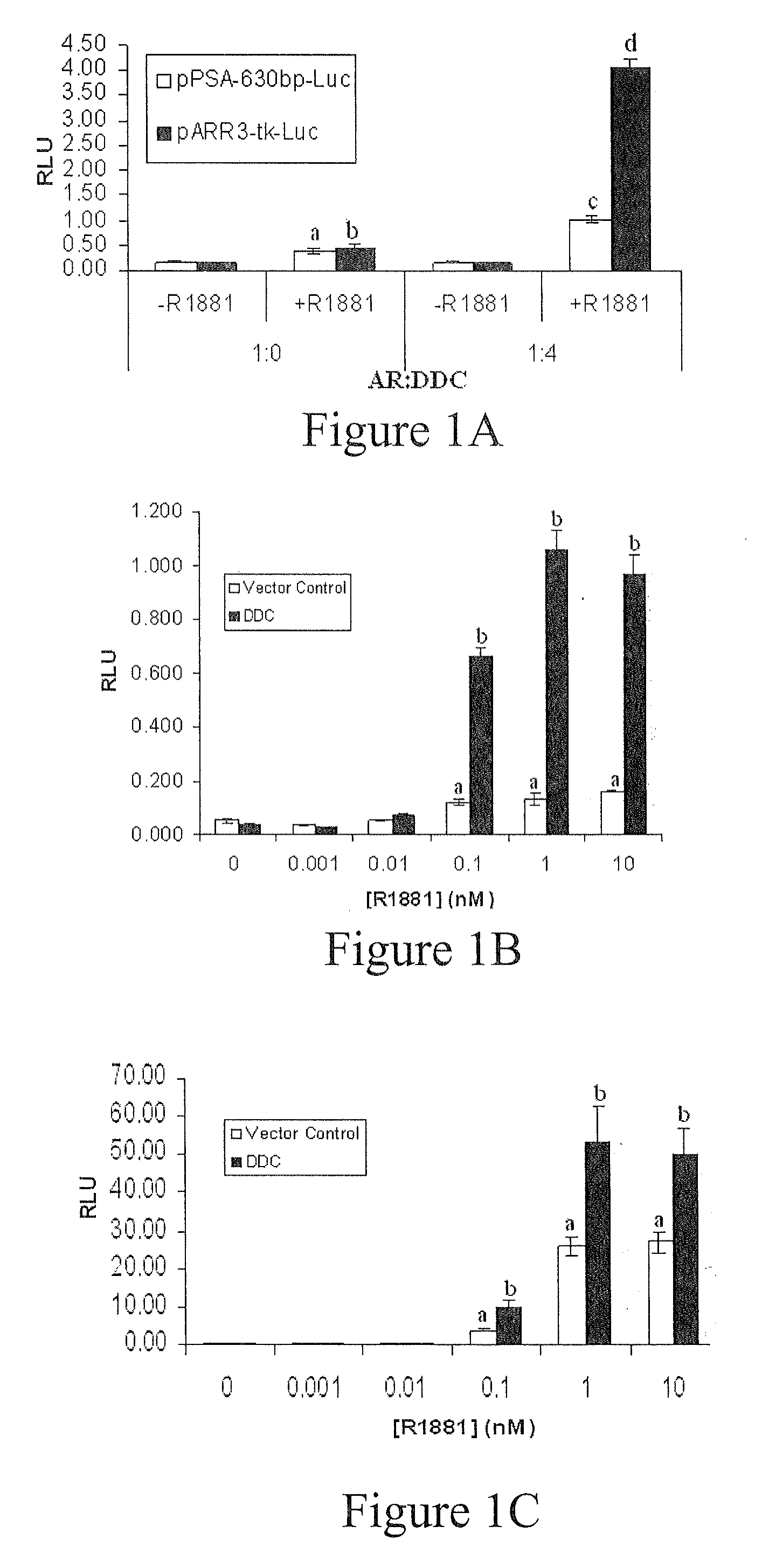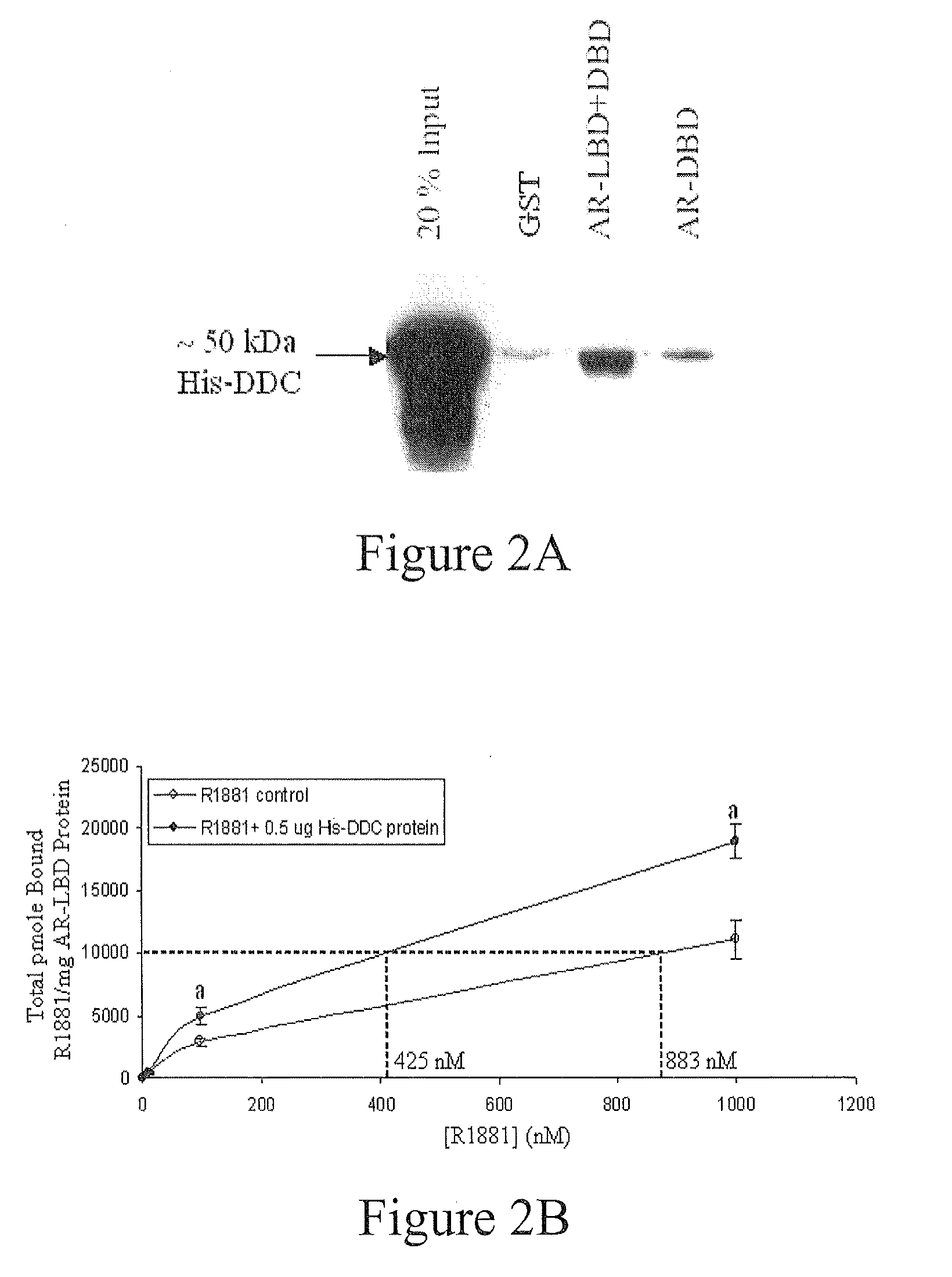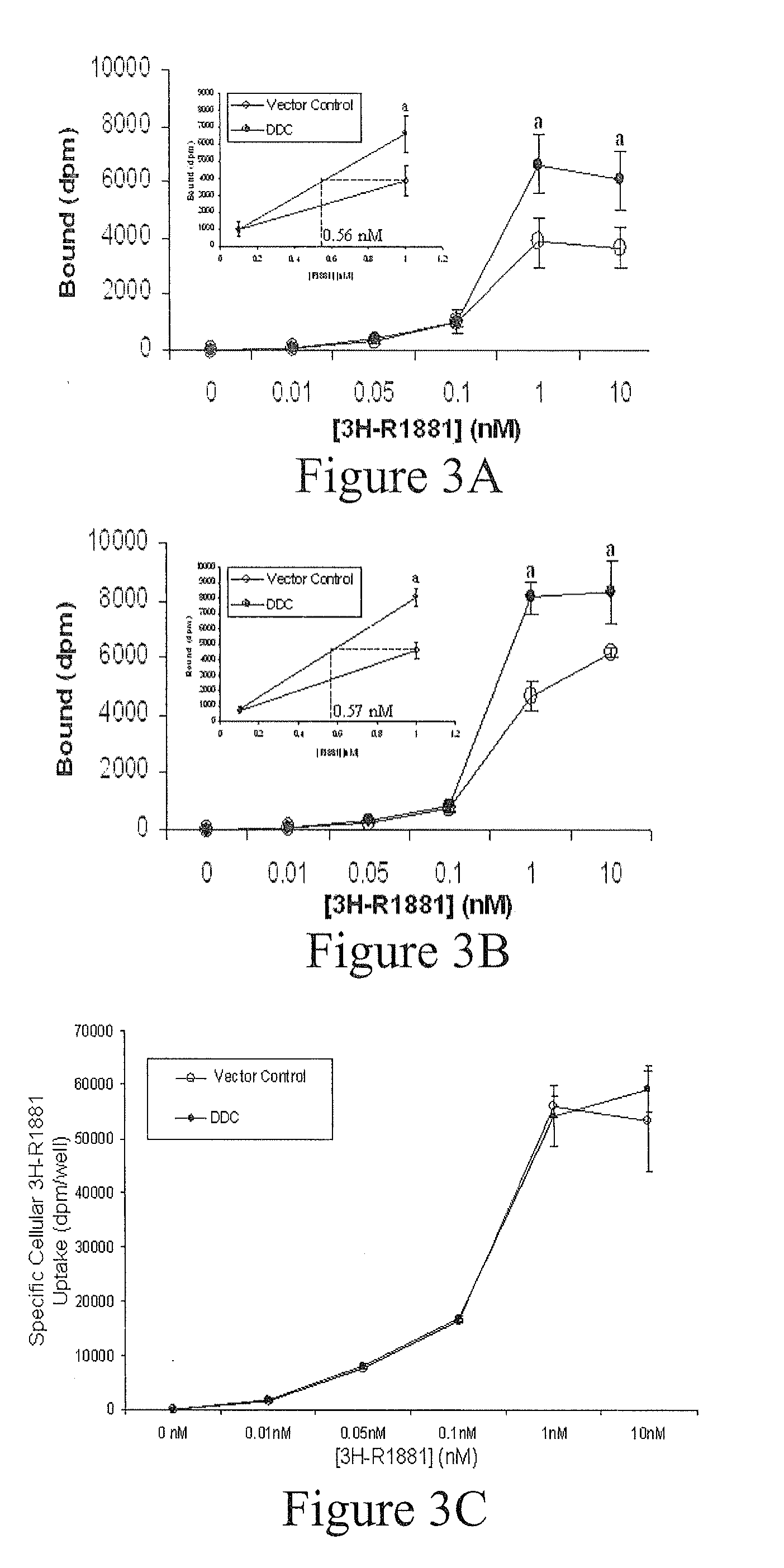Treatment of Prostate Cancer with DDC Inhibitor
a prostate cancer and inhibitor technology, applied in the field of cancer, can solve the problems of erectile dysfunction and other symptoms, obstructing the free flow of urine, and urinating difficulties, and achieve the effect of decreasing the affinity of androgen receptors
- Summary
- Abstract
- Description
- Claims
- Application Information
AI Technical Summary
Benefits of technology
Problems solved by technology
Method used
Image
Examples
example 1
DDC Enhances AR Transactivation from the Androgen-Regulated PSA Promoter and Sensitizes the Receptor to Limiting Androgen Concentrations
Description of Study Procedures
Plasmid Construction
[0075]The DDC expression plasmid, pDEST12.2-DDC, used for mammalian cells and for in vitro transcription / translation was cloned previously. Full-length human AR was cloned into the pcDNA3.1 mammalian expression plasmid (pcDNA3.1-hAR) under control of a cytomegalovirus (CMV) promoter.
Transactivation Assays
[0076]PC3 and LNCaP cells were transfected, treated with R1881 and used for luciferase assays, as described previously. Briefly, human AR expression plasmid (pcDNA3.1-hAR) and AR-regulated luciferase reporters, pARR3-tk-Luc or pPSA-630 bp-Luc (−630 / +12 bp of the 5′ PSA flanking region) {Snoek, 1998 #136}, were cotransfected into cells, along with DDC expression plasmid (pDEST12.2-DDC) or control empty vector (pDEST12.2). Firefly luciferase values were normalized to renilla luciferase (PRL-TK reporte...
example 2
DDC Increases the Apparent Affinity of AR for Androgen In Vitro
Description of Study Procedures
Plasmid Construction
[0078]The His-tagged-DDC bacterial expression plasmid was produced via RT-PCR on LNCaP RNA and Gateway™ cloning (Invitrogen). The forward (5′GGGGACAAGTTTGTACAAAAAAGCAGGCTTAAACGCAAGTGAATTCC GAAGGAGA-3′) SEQ ID NO. 1 and reverse (5′GGGGACCACTTTGTACAAGAAAGCTGGGTCCTACTCCCTCTCTGCTCG CAGCAC-3′) SEQ ID NO. 2 primers contained a stop codon, but lacked the ATG start site to allow for a 6×-His-tagged-DDC N-terminal fusion. Primers also included DDC gene-specific coding sequence (in bold) and attB1 / B2 recombination sites allowing incorporation of the PCR product into pDONR201 for generation of the pENTR-fusion-DDC vector. Upon frame and sequence verification, this entry vector was used for a recombination reaction with pDEST17 to produce the pDEST17-His-DDC bacterial expression plasmid (T7 promoter).
Mammalian Cell Culture
[0079]PC12 rat adrenal pheochromocytoma cells were grown in D...
example 3
DDC Elevates AR Androgen-Binding Capacity in Mammalian
Cells
Description of Study Procedures
Cell-Based Ligand Binding Assays
[0085]HeLa-AR cells were cultured for 24-48 hours in DMEM containing 5% DCC-FBS and seeded onto 6 cm plates at a density of 1×106 cells / plate. After 5 hours, cells were transfected with either pDEST12.2-DDC or pDEST12.2 control vector (5 μg / plate) using Lipofectin Reagent (Invitrogen). The next day, transfection mix was changed to DMEM supplemented with 5% DCC-FBS containing increasing concentrations of [3H]-R1881 (0-10 nM). To determine non-specific binding, hormone treatments were carried out in the presence (NSB) and absence (total binding) of excess cold 1000 nM R1881. After 24 hours of incubation with hormone, cells were harvested as described previously. Cytosolic fractions were prepared by resuspending cell pellets in Buffer A (10 mM HEPES pH 7.9, 10 mM KCl, 0.1 mM EDTA, 0.1 mM EGTA, 1 mM dithiothreitol / DTT, 0.5 mM phenylmethylsulfonyl fluoride / PMSF) and i...
PUM
| Property | Measurement | Unit |
|---|---|---|
| Therapeutic | aaaaa | aaaaa |
| Sensitivity | aaaaa | aaaaa |
| Affinity | aaaaa | aaaaa |
Abstract
Description
Claims
Application Information
 Login to View More
Login to View More - R&D
- Intellectual Property
- Life Sciences
- Materials
- Tech Scout
- Unparalleled Data Quality
- Higher Quality Content
- 60% Fewer Hallucinations
Browse by: Latest US Patents, China's latest patents, Technical Efficacy Thesaurus, Application Domain, Technology Topic, Popular Technical Reports.
© 2025 PatSnap. All rights reserved.Legal|Privacy policy|Modern Slavery Act Transparency Statement|Sitemap|About US| Contact US: help@patsnap.com



